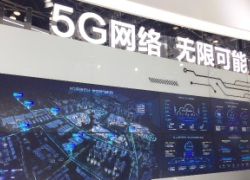At the PT Expo China 2017, in Beijing, Huawei is exhibiting the world’s first 5G network slicing application for smart grids. The application is based on Huawei’s 5G Core solution Service-Oriented Core (SOC), part of Huawei’s E2E 5G solution.
The exhibition demonstrates the overall automated establishment of 5G network slicing customised to service requirements. In addition, the exhibition demonstrates how the ultra-low latency of 5G can help restore power, within just 300 ms, to an area where the power lines have been damaged or power is lost for some other reason.
It also shows how 5G enables a smart distribution network and how it ensures secure, reliable, and stable operations on the power grid as a whole.
5G does not just offer higher data rates, it also enables a wide range of diverse industries to achieve digital transformation. The power grid industry is a typical vertical industry which could benefit. It requires high security, reliability, and performance for the proper provisioning of diverse services. According to Huawei’s Wireless X Labs research, constructing a smart distribution network on top of a communications network is key to an efficient, high-quality power grid.
Traditionally, the distribution network is constructed based on a dedicated or public carrier network. Building a dedicated network is expensive and inflexible. Public networks cannot isolate services well enough to keep services secure and latency low.
 5G network slicing is the ideal choice, dividing the telecommunications network into isolated network slices, allowing the power grid to be customised to specific industry needs. 5G network slicing lets utilities deliver reliable, high-performance services at a low price.
5G network slicing is the ideal choice, dividing the telecommunications network into isolated network slices, allowing the power grid to be customised to specific industry needs. 5G network slicing lets utilities deliver reliable, high-performance services at a low price.
Using 5G network slicing for smart grid services is a brand-new approach. Network resources provided by carriers can be converted to mutually isolated network slices, to meet the differentiated network requirements of various services on the smart grid. Network slicing can also be used to collect data on electricity usage, for distributed power, for pile control at electric vehicle charging stations, for precise load control, and for other crucial services a smart power grid should offer.
Huawei started researching on 5G core network slicing in 2014, and has been working with world leading carriers on joint innovation ever since. At MWC 2016, Huawei successfully demonstrated the world’s first E2E 5G network slicing application.
Working with the power industry is a good place to start with 5G network slicing applications. From there, they can be extended to other vertical industries. Huawei hopes that 5G network slicing will help promote digital transformation for all sorts of vertical industries. Huawei also wishes to build new win-win business models with all carriers, and with vertical industries.
Comment on this article below or via Twitter: @ VanillaPlus OR @jcvplus






